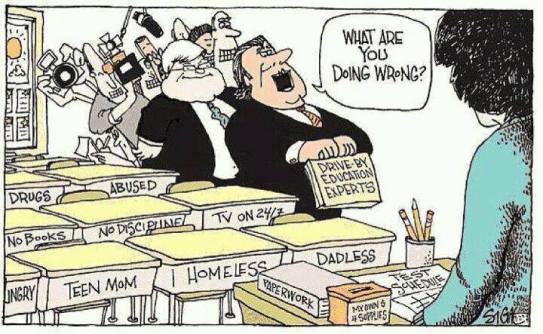Inside the classroom, the teacher has the greatest impact on student performance. It is also true that parents are the most influential teacher in a child’s life, and learning that doesn’t occur outside the classroom can have a much greater impact on student achievement, than what transpires inside the classroom…
“Decades of research have shown the staggering societal costs of children in poverty. They grow up with less education and lower earning power. They are more likely to have drug addiction, psychological trauma and disease, or wind up in prison…
Dasani’s circumstances are largely the outcome of parental dysfunction. While nearly one-third of New York’s homeless children are supported by a working adult, her mother and father are unemployed, have a history of arrests and are battling drug addiction….
For children like Dasani, school is not just a place to cultivate a hungry mind. It is a refuge. The right school can provide routine, nourishment and the guiding hand of responsible adults…
To eat, the children sit on the cracked linoleum floor, which never feels clean no matter how much they mop. Homework is a challenge. The shelter’s one recreation room can hardly accommodate Auburn’s hundreds of children, leaving Dasani and her siblings to study, hunched over, on their mattresses…
The projects may represent all kinds of inertia. But to live at Auburn is to admit the ultimate failure: the inability of one’s parents to meet that most basic need…
For all of McKinney’s pluck, its burdens are great. In the last six years, the city has cut the school’s budget by a quarter as its population declined. Fewer teachers share a greater load. After-school resources have thinned, but not the needs of students whose families are torn apart by gun violence and drug use. McKinney’s staff psychologist shuttles between three schools like a firefighter.
And now, a charter school is angling to move in. If successful, it will eventually claim McKinney’s treasured top floor, home to its theater class, dance studio and art lab. Teachers and parents are bracing for battle, announced by fliers warning against the “apartheid” effects of a charter co-location.
Dasani knows about charter schools. Her former school, P.S. 67, shared space with one. She never spoke to those children, whose classrooms were stocked with new computers. Dasani’s own school was failing by the time she left…
Miss Holmes has seen plenty of distressed children, but few have both the depth of Dasani’s troubles and the height of her promise. There is not much Miss Holmes can do about life outside school. She knows this is a child who needs a sponsor, who “needs to see ‘The Nutcracker,’” who needs her own computer. There are many such children.
Here at school, Miss Holmes must work with what she has…”
Andrea Elliott, “Invisible Child – Girl in the Shadows: Dasani’s Homeless Life” NY Times, 12/9/13
Poorer communities and schools would see a much greater academic return on their “investments” if instead of purchasing new computers, software solutions, and standardized tests, they properly funded programs such as; prenatal care, child care, adult ed, parenting classes, job coaching, drug counseling, health services, morning programs, and after school programs that provide meals, tutoring, arts and crafts, physical activity, and a quiet place to study.
It is naive to expect that students who have weaker academic skills, greater social and emotional needs, and attend chronically underfunded schools will start to achieve more in the classroom, simply because their state has adopted the Common Core State Standards, their schools have purchased computers to administer mandated standardized tests, and their teachers have received high quality Common Core professional development.
There is more likely to be an increase in the achievement gap and school drop out rates, rather than an increase in college and career readiness, if we continue to place greater academic demands on students with greater needs, without providing sufficient school funding to support essential wrap around services.


Pingback: Standards Are Expectations of Learning | WagTheDog
Pingback: Common Core: A Matter of Perspective | WagTheDog
Pingback: Cognitive Privilege | WagTheDog
Pingback: #whatif… | WagTheDog